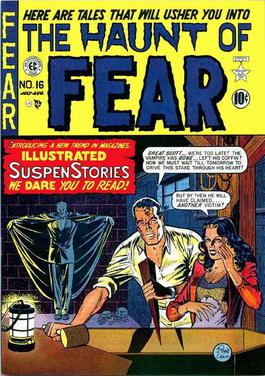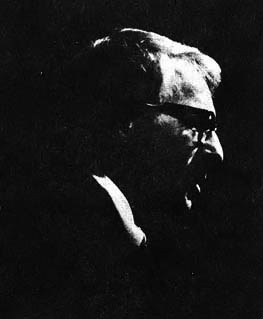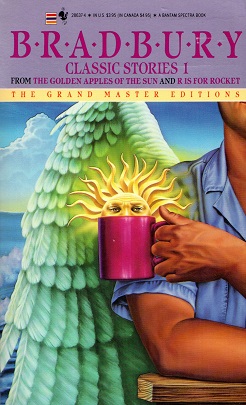
Fahrenheit 451 is a 1953 dystopian novel by American writer Ray Bradbury. It presents a future American society where books have been personified and outlawed and "firemen" burn any that are found. The novel follows in the viewpoint of Guy Montag, a fireman who soon becomes disillusioned with his role of censoring literature and destroying knowledge, eventually quitting his job and committing himself to the preservation of literary and cultural writings.

Ray Douglas Bradbury was an American author and screenwriter. One of the most celebrated 20th-century American writers, he worked in a variety of genres, including fantasy, science fiction, horror, mystery, and realistic fiction.

Theodore Sturgeon was an American fiction author of primarily fantasy, science fiction, and horror, as well as a critic. He wrote approximately 400 reviews and more than 120 short stories, 11 novels, and several scripts for Star Trek: The Original Series.

The Illustrated Man is a 1951 collection of 18 science fiction short stories by American writer Ray Bradbury. A recurring theme throughout the stories is the conflict of the cold mechanics of technology and the psychology of people. It was nominated for the International Fantasy Award in 1952.

The Golden Apples of the Sun is an anthology of 22 short stories by American writer Ray Bradbury. It was published by Doubleday & Company in 1953.
"The Fog Horn" is a 1951 science fiction short story by American writer Ray Bradbury, the first in his collection The Golden Apples of the Sun. The story was the basis for the 1953 action horror film The Beast from 20,000 Fathoms.

The Vault of Horror was an American bi-monthly horror comic anthology series published by EC Comics in the early 1950s. Along with Tales from the Crypt and The Haunt of Fear, it formed a trifecta of popular EC horror anthologies. The Vault of Horror hit newsstands with its April/May 1950 issue and ceased publication with its December/January 1955 issue, producing a total of 40 issues.

The Haunt of Fear was an American bi-monthly horror comic anthology series published by EC Comics, starting in 1950. Along with Tales from the Crypt and The Vault of Horror, it formed a trifecta of popular EC horror anthologies. The Haunt of Fear was sold at newsstands beginning with its May/June 1950 issue.

Crime SuspenStories was a bi-monthly anthology crime comic published by EC Comics in the early 1950s. The title first arrived on newsstands with its October/November 1950 issue and ceased publication with its February/March 1955 issue, producing a total of 27 issues. Years after its demise, the title was reprinted in its entirety, and four stories were adapted for television in the HBO's Tales From The Crypt.

Weird Science was an American science fiction comic book magazine that was part of the EC Comics line in the early 1950s. Over a four-year span, the comic ran for 22 issues, ending with the November–December, 1953 issue. Weird Fantasy was a sister title published during the same time frame.

A Memory of Murder (1984) is a collection of fifteen mystery short stories by American writer Ray Bradbury. They were originally published from 1944 to 1948 in pulp magazines owned by Popular Publications, Inc. that specialized in detective and crime fiction. Bradbury tried his hand in the genre but found the results unsatisfactory. He referred to the stories as "the walking wounded" in his introduction to A Memory of Murder.
The Ray Bradbury Theatre is an anthology series that ran for three seasons on First Choice Superchannel in Canada and HBO in the United States from 1985 to 1986, and then on USA Network, running for four additional seasons from 1988 to 1992; episodes aired on the Global Television Network in Canada from 1991 to 1994. It was shown in reruns on the Sci Fi Channel and later on the Retro Television Network. It currently airs on Comet and can be streamed on IMDb TV, Peacock, Pluto TV and The Roku Channel.
"The Pedestrian" is a science fiction short story by American writer Ray Bradbury. Originally published in the August 7, 1951 issue of The Reporter by The Fortnightly Publishing Company, the story was included in the collection The Golden Apples of the Sun (1953), but was dropped from later editions of this collection.

Bradbury Stories: 100 of His Most Celebrated Tales (2003) is a collection of short stories by Ray Bradbury. Bradbury wrote an introduction to the collection where he speaks about some of the inspirations, influences and among other things, the comedy duo Laurel and Hardy. The collection repeats no stories from The Stories of Ray Bradbury.
"The Flying Machine" is a short story written by Ray Bradbury in 1953. Bradbury also adapted the tale into a short play that same year.

"The Murderer" (1953) is a short story by Ray Bradbury, published in his collection The Golden Apples of the Sun.

The following is a list of works by Ray Bradbury.

Long After Midnight is a short story collection by American writer Ray Bradbury. Several of the stories are original to this collection. Others originally appeared in the magazines Planet Stories, Collier's Weekly, Playboy, Esquire, Welcome Aboard, Other Worlds, Cavalier, Gallery, McCall's, Woman's Day, Harper's, Charm, Weird Tales, Eros, and Penthouse.

Classic Stories 1: From The Golden Apples of the Sun and R is for Rocket is a semi-omnibus edition of two short story collections by Ray Bradbury: The Golden Apples of the Sun (1953) and R is for Rocket (1962).
"The Rocket" is a science fiction short story by American writer Ray Bradbury, published in 1950. It is also included in The Illustrated Man, a collection of short stories by Ray Bradbury.















